Effects of Ocimum gratissimum and Citric Acid on the Nutritive and Sensory Qualities of Stored Pineapple Juice
Oladapo Sinmiat Abiodun1*, Akinyosoye Felix Akinsola2, Adebolu TT2, Ojokoh AO2
1Food Science and Technology Department, Osun State Polytechnic, Osun State, Nigeria
2Microbiology Department, Federal University of Technology, Ondo State, Nigeria
*Corresponding Author: Oladapo Sinmiat Abiodun, Food Science and Technology Department, Osun State Polytechnic, Osun State, Nigeria
Received: 28 March 2020; Accepted: 07 April 2020; Published: 22 April 2020
Article Information
Citation: Oladapo Sinmiat Abiodun, Akinyosoye Felix Akinsola, Adebolu TT, Ojokoh AO. Effects of Ocimum gratissimum and Citric Acid on the Nutritive and Sensory Qualities of Stored Pineapple Juice. Journal of Food Science and Nutrition Research 3 (2020): 034-049.
DOI: 10.26502/jfsnr.2642-11000037
View / Download Pdf Share at FacebookAbstract
Fruit juices values are reduced during the storage, its effect is of great concern to the consumer as well as to the economy of our great nation. Effects of leaf extract Ocimum gratissimum and citric acid on the proximate and sensory properties of stored at 30 ± 2°C pineapple juice was investigated using standard techniques. The extracted juice was divided into two-part, one part was treated with leaf extract O. gratissimum ranged from 5% - 40% while; the second part was treated with citric acid ranged from 0.2% - 0.5% and untreated one served as control. They were stored 10 days at ambient temperature. The results obtained revealed the concentration 40% leaf extract and 0.5% citric acid were able to stabilize the nutritional qualities during the storage. The moisture content for the best leaf extract at 40% concentration ranged from 77.95 ± 0.08% - 78.34 ± 0.05% while citric acid (0.5%) moisture effect ranged from 85.42 0.00% - 85.72 ± 0.06% and the untreated moisture content ranged from 85.42 ± 0.02% to 93.19 ± 0.00%. The ash content of leaf extract and citric acid-treated pineapple ranged from 1.10 ± 0.01% - 1.11 ± 0.01% and 0.30 ± 0.00% - 0.32 ± 0.00% while untreated juice ranged from 0.17 ± 0.00% to 0.32 ± 0.00%. The protein content of leaf extract and citric acid-treated pineapple ranged from 2.24 ± 0.01% - 2.29 ± 0.01% and 1.07 ± 0.01% - 1.08 ± 0.01% while untreated juice ranged from 0.95 ± 0.00% to 1.09 ± 0.00%. The carbohydrate content of leaf extract and citric acid-treated pineapple ranged 15.38 ± 0.00% - 15.46 ± 0.00% and 11.81 ± 0.00% - 11.95 ± 0.00% while untreated juice ranged from 5.10 ± 0.01% to 11.94 ± 0.00%. The fibre content of leaf extract and citric acid-treated pineapple ranged 2.41 ± 0.00% - 2.43 ± 0.01% and 0.95 ± 0.01% -
Keywords
Fruit juice, Ocimum gratissimum leaf extract, Citric acid, Nutritive and sensory values
Fruit juice articles, Ocimum gratissimum leaf extract articles, Citric acid articles, Nutritive and sensory values articles
Fruit juice articles Fruit juice Research articles Fruit juice review articles Fruit juice PubMed articles Fruit juice PubMed Central articles Fruit juice 2023 articles Fruit juice 2024 articles Fruit juice Scopus articles Fruit juice impact factor journals Fruit juice Scopus journals Fruit juice PubMed journals Fruit juice medical journals Fruit juice free journals Fruit juice best journals Fruit juice top journals Fruit juice free medical journals Fruit juice famous journals Fruit juice Google Scholar indexed journals Ocimum gratissimum leaf extract articles Ocimum gratissimum leaf extract Research articles Ocimum gratissimum leaf extract review articles Ocimum gratissimum leaf extract PubMed articles Ocimum gratissimum leaf extract PubMed Central articles Ocimum gratissimum leaf extract 2023 articles Ocimum gratissimum leaf extract 2024 articles Ocimum gratissimum leaf extract Scopus articles Ocimum gratissimum leaf extract impact factor journals Ocimum gratissimum leaf extract Scopus journals Ocimum gratissimum leaf extract PubMed journals Ocimum gratissimum leaf extract medical journals Ocimum gratissimum leaf extract free journals Ocimum gratissimum leaf extract best journals Ocimum gratissimum leaf extract top journals Ocimum gratissimum leaf extract free medical journals Ocimum gratissimum leaf extract famous journals Ocimum gratissimum leaf extract Google Scholar indexed journals Citric acid articles Citric acid Research articles Citric acid review articles Citric acid PubMed articles Citric acid PubMed Central articles Citric acid 2023 articles Citric acid 2024 articles Citric acid Scopus articles Citric acid impact factor journals Citric acid Scopus journals Citric acid PubMed journals Citric acid medical journals Citric acid free journals Citric acid best journals Citric acid top journals Citric acid free medical journals Citric acid famous journals Citric acid Google Scholar indexed journals Nutritive and sensory values articles Nutritive and sensory values Research articles Nutritive and sensory values review articles Nutritive and sensory values PubMed articles Nutritive and sensory values PubMed Central articles Nutritive and sensory values 2023 articles Nutritive and sensory values 2024 articles Nutritive and sensory values Scopus articles Nutritive and sensory values impact factor journals Nutritive and sensory values Scopus journals Nutritive and sensory values PubMed journals Nutritive and sensory values medical journals Nutritive and sensory values free journals Nutritive and sensory values best journals Nutritive and sensory values top journals Nutritive and sensory values free medical journals Nutritive and sensory values famous journals Nutritive and sensory values Google Scholar indexed journals health-promoting articles health-promoting Research articles health-promoting review articles health-promoting PubMed articles health-promoting PubMed Central articles health-promoting 2023 articles health-promoting 2024 articles health-promoting Scopus articles health-promoting impact factor journals health-promoting Scopus journals health-promoting PubMed journals health-promoting medical journals health-promoting free journals health-promoting best journals health-promoting top journals health-promoting free medical journals health-promoting famous journals health-promoting Google Scholar indexed journals nutritional composition articles nutritional composition Research articles nutritional composition review articles nutritional composition PubMed articles nutritional composition PubMed Central articles nutritional composition 2023 articles nutritional composition 2024 articles nutritional composition Scopus articles nutritional composition impact factor journals nutritional composition Scopus journals nutritional composition PubMed journals nutritional composition medical journals nutritional composition free journals nutritional composition best journals nutritional composition top journals nutritional composition free medical journals nutritional composition famous journals nutritional composition Google Scholar indexed journals viral infections articles viral infections Research articles viral infections review articles viral infections PubMed articles viral infections PubMed Central articles viral infections 2023 articles viral infections 2024 articles viral infections Scopus articles viral infections impact factor journals viral infections Scopus journals viral infections PubMed journals viral infections medical journals viral infections free journals viral infections best journals viral infections top journals viral infections free medical journals viral infections famous journals viral infections Google Scholar indexed journals antioxidant articles antioxidant Research articles antioxidant review articles antioxidant PubMed articles antioxidant PubMed Central articles antioxidant 2023 articles antioxidant 2024 articles antioxidant Scopus articles antioxidant impact factor journals antioxidant Scopus journals antioxidant PubMed journals antioxidant medical journals antioxidant free journals antioxidant best journals antioxidant top journals antioxidant free medical journals antioxidant famous journals antioxidant Google Scholar indexed journals Pasteurization articles Pasteurization Research articles Pasteurization review articles Pasteurization PubMed articles Pasteurization PubMed Central articles Pasteurization 2023 articles Pasteurization 2024 articles Pasteurization Scopus articles Pasteurization impact factor journals Pasteurization Scopus journals Pasteurization PubMed journals Pasteurization medical journals Pasteurization free journals Pasteurization best journals Pasteurization top journals Pasteurization free medical journals Pasteurization famous journals Pasteurization Google Scholar indexed journals
Article Details
1. Introduction
Pineapple (Bromeliaceae family) is amongst the major Nigeria fruits produced in large quantities but significantly wasted at the peak of harvesting. This fruit can be processed into some products; canned pineapple slice, pineapple pulp, dried pineapple, pasteurized pineapple juice, and concentrate. The day 1 pineapple juice is a popular product due to its pleasant aroma, flavor, and numerous functional properties [1]. The pineapple juice satisfies the “5 A Day” dietary requirement of fruits and vegetables set by many health agencies [2]. The juice contains a variety of minerals, especially manganese, as well as amino acids, various sugars, vitamins, and polyphenols [3-4]. It is considered as a vital drink due to its health-promoting properties and its anti-inflammatory, anti-atherosclerotic, anti-aging, and many other healing properties. The nutritional composition of pineapple juice depends on the geographical location, culture, harvest season, and processing time. Studies have reported on the general composition of pineapple juice such as minerals, sugars, organic acids, and amino acids, as well as physical properties such as pH, Brix, ash, and titratable acidity [3]. The edible portion of pineapple fruit has been investigated and contains 81.2 to 86.2% moisture, and 13-19% total solids, of which sucrose, glucose, and fructose are the main components. Carbohydrates represent up to 85% of total solids whereas fibre makes up for 2-3%. The pulp has very low ash content, nitrogenous compounds and lipids (0.1%). From 25-30% of nitrogenous compounds are true proteins. Day 1 pineapple juice contains Calcium, Chlorine, Potassium, Phosphorus, and Sodium [5]. Pineapple juice contains ascorbic (Vitamin C) which assists the body in fighting bacterial and viral infections It is an effective antioxidant and helps the body to absorb iron. Pineapples juice also contains copper (trace) which assists in the absorption of iron and regulates blood pressure and heart rate [6].
Tree basil Ocimum gratissimum Linn. is a small shrub, also known as clove basil African scent leaf, tea bush or fever plant [7] The plant (Ocimum gratissimum) is called Efinrin in Yoruba, Daidoya in Hausa Nchuawu in Igbo [7-8]. The typical characteristics of the family Lamiaceae to which O. gratissimum belongs have a square stem, opposite and decussate leaves with many gland dots. Extracts O. gratissimum is used in traditional medicines, and have been shown to contain biologically active constituents that are insecticidal, nematicidal, fungistatic, or antimicrobial [9]. Phytochemical analysis of Ocimum gratissimum leaf showed that it contains alkaloids, flavonoids, saponin, tannins, glycoside, cardiac glycoside, resin compounds, terpenoids, and essential oil. These classes of compounds have curative effects against microorganisms. Pasteurization is the conventional method of stabilizing fruit juice quality through it shelf life. However, the concerns about the shortcomings inherent in the pasteurization method have called for the exploitation of alternative methods. The restriction imposed by the regulatory agencies on the use of some synthetic food additive is an impetus to finding alternative natural antimicrobial compounds that could be used for the preservation of fruit juices [10].
The present study therefore aimed at exploring the plant leaf aqueous extract of (Ocimum gratissimum) to preserve the nutritive and sensory qualities of pineapple juice for a longer period of time at ambient temperature.
2. Materials and Methods
Mature and healthy, pineapple fruits were bought at the Oba Adesida market in Akure, Ondo State Nigeria while, citric acid was collected from Microbiology Department, Federal University of Technology Akure, Ondo State Nigeria. Ocimum gratissimum Linn. leaf was obtained from a garden at Ede in Osun State Nigeria. The O. gratissimum leaf was authenticated by a Botanist at the Forestry and Wood Technology Department, Federal University of Technology Akure.
2.1 Preparation of plant leaf extract and juice
The mature and healthy leaves of Ocimum gratissimum were manually separated cleaned, air-dried and pulverized. The leaf powdered was extracted at 70 ± 2°C with sterile distilled water for 48 hours in a shaker water bath. The resulting mixture was filtered by passing through the Watman No1 filter paper and filtrate collected was dried at ambient temperature (30 ± 2°C) and grounded into a fine powder using mortar and pestle. The obtained dried crude extracts were kept into an airtight plastic container and labeled. Different concentrations of the crude plant extract (5% to 40%) and citric acid (0.2% to 0.5%) was prepared using sterile distilled water [11-12]. The pineapple fruit for the study was washed, peeled and cut into smaller pieces and poured into a blender in an aseptic condition. The extracted fruit juice was divided into 24 pet bottles (100 ml) and each was preserved with different concentrations (5.0% - 40%) of O. gratissimum aqueous solutions and citric acid 0.2% - 0.5%.
2.2 Proximate and Sensory Analysis
The proximate parameters (Crude protein, crude fibre, fat and dry matter) of the pineapple juice were determined using the official methods of analysis [13]. The carbohydrate content was calculated by difference. A sensory evaluation was carried out on the juice samples. A nine-point Hedonic scale and Analysis of variance (ANOVA) [14] were utilized. Ten semi-trained panelists were recruited. They were served the juice samples in coded cups. The panelists assessed the taste, colour, flavors and general acceptability of the samples using a nine-point Hedonic scale where 1 = dislike extremely and 9 = like extremely.
3. Results
3.1 Effect of different concentrations O. gratissimum leaf extract of citric acid on the moisture content of pineapple juice stored at 30 ± 2oC for 10 days
Prior to the addition of different concentrations O. gratissimum leaf extract and citric acid to pineapple juice, the moisture content ranged from 85.42 ± 0.02% to 93.19 ± 0.00% for the day 1 prepared juice by 10 days of storage at 30 ± 2°C. Addition of the concentration 5% of O. gratissimum leaf extract and 0.2% citric acid did not significantly (p ≤ 0.05) reduce the moisture content of pineapple juice during the storage so also increase in the percentage of leaf extract and citric acid up to 30% and 0.4%. However, the addition of the O. gratissimum (40%) and citric acid up to 0.5% significantly (p ≤ 0.05) reduces the moisture content to 77.95 ± 0.08% on day 1 and 78.34 ± 0.05% of the juice stored for 10 days while 0.5% concentration of citric acid significantly (p ≤ 0.05) reduce the MC to 85.42 0.00% for day 1 and 85.72 ± 0.06% for day 5 of storage at the ambient temperature of 30 ± 2°C. The concentration of 40% O gratissimum leaf extract was the most effective in reducing the MC content thereby increase the shelf life. The results of different concentrations of O. gratissimum plant leaf extract on the moisture content (MC) of pineapple juice stored at 30 ± 2°C for 10 days are shown in Figure 1.
3.2 Effect of different concentrations of Ocimum gratissimum leaf extract and citric acid on the ash content of pineapple juice stored at 30 ± 2°C for 10 days
Prior to the addition of different concentrations O. gratissimum leaf extract and citric acid to pineapple juice, the ash content ranged from 0.17 ± 0.00% to 0.32 ± 0.00% for the day 1 prepared juice by 10 days of storage at 30 ± 2°C. Addition of the concentration 5% of O. gratissimum leaf extract and 0.2% citric acid significantly (p ≤ 0.05) reduce the ash content of pineapple juice during the storage so also increase in the percentage of leaf extract and citric acid up to 30% and 0.4%. However, the addition of the O. gratissimum (40%) and citric acid up to 0.5% significantly (p ≤ 0.05) increases and stabilizes the ash content to 1.10 ± 0.01% on day 1 and 1.11 ± 0.01% of the juice stored for 10 days while 0.5% concentration of citric acid significantly (p ≤ 0.05) stabilizes the ash content 0.32 ± 0.00% for day 1 and .10 days 0.30 ± 0.00% of storage at the ambient thof 30 ± 2°C. As the concentration O. gratissimum leaf extract increases there was an increase in ash content of the stored pineapple juice. The results of different concentrations of O. gratissimum plant leaf extract and citric acid on the ash content of pineapple juice stored at 30 ± 2°C for 10 days are shown in Figure 2.
3.3 Effect of different concentrations of Ocimum gratissimum leaf extract and citric acid on the carbohydrate content of pineapple juice stored at 30 ± 2°C for 10 days
Prior to the addition of different concentrations O. gratissimum leaf extract and citric acid to pineapple juice, the carbohydrate content ranged from 11.94 ± 0.00% to 5.10 ± 0.01% for the day 1 prepared juice by 10 days of storage at 30 ± 2°C. Addition of the concentration 5% of O. gratissimum leaf extract and 0.2% citric acid significantly (p ≤ 0.05) reduce the carbohydrate content of pineapple juice during the storage so also increase in the percentage of leaf extract and citric acid up to 30% and 0.4%. However, the addition of the O. gratissimum (40%) and citric acid up to 0.5% significantly (p ≤ 0.05) increases and stabilizes the carbohydrate content to 15.46 ± 0.00% on day 1 and 15.38 ± 0.00% of the juice stored for 10 days while 0.5% concentration of citric acid significantly (p ≤ 0.05) reduces the carbohydrate content 11.95 ± 0.00% for day 1 and 10 days 11.81 ± 0.00% of storage at ambient temperature of 30 ± 2°C. As the concentration O. gratissimum leaf extract increases there was an increase in carbohydrate content of the stored pineapple juice. The results of different concentrations of O. gratissimum plant leaf extract on the carbohydrate content of pineapple juice stored at 30 ± 2°C for 10 days are shown in Figure 3.
3.4 Effect of different concentrations of Ocimum gratissimum leaf extract and citric acid on the protein content of pineapple juice stored at 30 ± 2°C for 10 days
Prior to the addition of different concentrations O. gratissimum leaf extract and citric acid to pineapple juice, the protein content ranged from 0.95 ± 0.00% to 1.09 ± 0.00% for day 1 prepared juice by 10 days of storage at 30 ± 2°C. Addition of the concentration 5% of O. gratissimum leaf extract and 0.2% citric acid significantly (p ≤ 0.05) reduce the protein content of pineapple juice during the storage so also increase in the percentage of leaf extract and citric acid up to 30% and 0.4%. However, the addition of the O. gratissimum (40%) and citric acid up to 0.5% significantly (p ≤ 0.05) increases and stabilizes the protein content to 2.29 ± 0.00% on day 1 and 2.24 ± 0.00% of the juice stored for 10 days while 0.5% concentration of citric acid significantly (p ≤ 0.05) reduces the protein content 1.08 ± 0.01% for day 1 and 1.07 ± 0.01% for 10 days of storage at an ambient temperature of 30 ± 2°C. As the concentration O. gratissimum leaf extract increases there was an increase in protein content of the stored pineapple juice.The results of different concentrations of O. gratissimum plant leaf extract on the protein content of pineapple juice stored at 30 ± 2°C for 10 days is shown Figure 4.
3.5 Effect of different concentrations of Ocimum gratissimum leaf extract and citric acid on the fat content of pineapple juice stored at 30 ± 2°C for 10 days
Prior to the addition of different concentrations O. gratissimum leaf extract and citric acid to pineapple juice, the fat content ranged from 0.08 ± 0.00% to 0.20 ± 0.01% for day 1 prepared juice by 10 days of storage at 30 ± 2°C. Addition of the concentration 5% of O. gratissimum leaf extract and 0.2% citric acid significantly (p ≤ 0.05) reduce the fat content of pineapple juice during the storage so also increase in the percentage of leaf extract and citric acid up to 30% and 0.4%. However, the addition of the O. gratissimum (40%) and citric acid up to 0.5% significantly (p ≤ 0.05) increases and stabilizes the fat content to 2.29 ± 0.00% on day 1 and 2.24 ± 0.00% of the juice stored for 10 days while 0.5% concentration of citric acid significantly (p ≤ 0.05) reduces the fat content 0.61 ± 0.00% for day 1 and 0.51 ± 0.01% for 10 days of storage at the ambient temperature of 30 ± 2°C. As the concentration O. gratissimum leaf extract increases, there was an increase in fat content of the stored pineapple juice. The results of different concentrations of O. gratissimum plant leaf extract on the fat content of pineapple juice stored at 30 ± 2°C for 10 days are shown in Figure 5.
3.6 Effect of different concentrations of Ocimum gratissimum leaf extract and citric acid on fibre content of pineapple juice stored at 30 ± 2°C for 10 days
Prior to the addition of different concentrations O. gratissimum leaf extract and citric acid to pineapple juice, the fibre content ranged from 0.52 ± 0.01% to 1.03 ± 0.01% for the day 1 prepared juice by 10 days of storage at 30 ± 2°C. Addition of the concentration 5% of O. gratissimum leaf extract and 0.2% citric acid significantly (p ≤ 0.05) reduce the fibre content of pineapple juice during the storage so also increase in percentage of leaf extract and citric acid up to 30% and 0.4%. However, the addition of the O. gratissimum (40%) and citric acid up to 0.5% significantly (p ≤ 0.05) increases and stabilizes the fibre content to 2.43 ± 0.01% on day 1 and 2.41 ± 0.00% of the juice stored for 10 days while 0.5% concentration of citric acid significantly (p ≤ 0.05) reduces the fibre content 1.03 ± 0.01% for day 1 and 0.95 ± 0.01% for 10 days of storage at an ambient temperature of 30 ± 2°C. As the concentration O. gratissimum leaf extract increases there was increase in fibre content of the stored pineapple juice at day 1. The results of different concentrations of O. gratissimum plant leaf extract on the fibre content of pineapple juice stored at 30 ± 2°C for 10 days are shown Figure 6.
3.7 Effect of different concentrations of Ocimum gratissimum leaf extract and citric acid on taste of pineapple juice stored at 30 ± 2°C for 10 days
Prior to the addition of different concentrations O. gratissimum leaf extract and citric acid to pineapple juice, the taste content ranged from 2.89 ± 0.78 to 8.33 ± 0.50 for day 1 prepared juice by 10 days of storage at 30 ± 2°C. Addition of the concentration 5% of O. gratissimum leaf extract and 0.2% citric acid significantly (p ≤ 0.05) reduce the taste content of pineapple juice during the storage so also increase in the percentage of leaf extract and citric acid up to 30% and 0.4%. However, the addition of the O. gratissimum (40%) and citric acid up to 0.5% significantly (p ≤ 0.05) increases and stabilizes the taste content to 7.78 ± 0.67 on day 1 and throughout of the juice stored for 10 days while 0.5% concentration of citric acid significantly (p ≤ 0.05) reduce the taste content to 7.22 ± 1.20 for day 1 and 7.11 ± 1.45 for 10 days of storage at ambient temperature of 30 ± 2°C. As the concentration As the O. gratissimum leaf extract increases, there was a decrease in the taste content of the stored pineapple juice on day 1. The O. gratissimum leaf extract did not compare favourable with the citric acid on the taste of pineapple juice. The results of different concentrations of O. gratissimum leaf extract and citric acid on the taste content of pineapple juice stored at 30 ± 2°C for 10 days are shown in Figure 7.
3.8 Effect of different concentrations of Ocimum gratissimum leaf extract and citric acid on colour of pineapple juice stored at 30 ± 2°C for 10 days
Prior to the addition of different concentrations O. gratissimum leaf extract and citric acid to pineapple juice, the colour content ranged from 2.44 ± 0.53 to 7.78 ± 0.44 for the day 1 prepared juice by 10 days of storage at 30 ± 2°C. Addition of the concentration 5% of O. gratissimum leaf extract and 0.2% citric acid significantly (p ≤ 0.05) reduce the colour content of pineapple juice during the storage so also increase in percentage of leaf extract and citric acid up to 30% and 0.4%. However, the addition of the O. gratissimum (40%) and citric acid up to 0.5% significantly (p ≤ 0.05) increases and stabilizes the colour content to 5.22 ± 0.83 on day 1 and 7.33 ± 0.87 of the juice stored for 10 days while 0.5% concentration of citric acid significantly (p ≤ 0.05) stabilizes the colour content to 7.89 ± 0.60 for 10 days of storage at the ambient temperature of 30 ± 2°C. As the concentration As the O. gratissimum leaf extract increases, there was decrease in colour content of the stored pineapple juice at day 1. The O. gratissimum leaves extract compare favourable with the citric acid on the colour of pineapple juice. The results of different concentrations of O. gratissimum leaf extract and citric acid on the colour content of pineapple juice stored at 30 ± 2°C for 10 days are shown in Figure 8.
3.9 Effect of different concentrations of Ocimum gratissimum leaf extract and citric acid on the flavour of pineapple juice stored at 30 ± 2oC for 10 days
Prior to the addition of different concentrations O. gratissimum leaf extract and citric acid to pineapple juice, the flavour content ranged from 2.44 ± 0.53 to 8.11 ± 1.05 for the day 1 prepared juice by 10 days of storage at 30 ± 2°C. Addition of the concentration 5% of O. gratissimum leaf extract and 0.2% citric acid significantly (p ≤ 0.05) reduce the flavour content of pineapple juice during the storage so also increase in percentage of leaf extract and citric acid up to 30% and 0.4%. However, the addition of the O. gratissimum (40%) and citric acid up to 0.5% significantly (p ≤ 0.05) increases and stabilizes the flavour content to 6.56 ± 0.53 on day 1 and 6.56 ± 0.53 of the juice stored for 10 days while 0.5% concentration of citric acid significantly (p ≤ 0.05) reduce the flavour content to 8.11 ± 1.05 for day 1 and 7.56 ± 0.88 for 10 days of storage at ambient temperature of 30 ± 2°C. As the concentration As the O. gratissimum leaf extract increases, there was a decrease in flavour content of the stored pineapple juice on day 1. The O. gratissimum leaves extract did not compare favourable with the citric acid on the flavour of pineapple juice. The results of different concentrations of O. gratissimum leaf extract and citric acid on the flavour content of pineapple juice stored at 30 ± 2°C for 10 days are shown in Figure 9.
3.10 Effect of different concentrations of Ocimum gratissimum leaf extract and citric acid on the general acceptability of pineapple juice stored at 30 ± 2°C for 10 days
Prior to the addition of different concentrations O. gratissimum leaf extract and citric acid to pineapple juice, the general acceptability by the panelists ranged from 2.44 ± 0.53 to 8.11 ± 1.05 for the day 1 prepared juice by 10 days of storage at 30 ± 2°C. Addition of the concentration 5% of O. gratissimum leaf extract and 0.2% citric acid significantly (p ≤ 0.05) reduce the general acceptability content of pineapple juice during the storage so also increase in the percentage of leaf extract and citric acid up to 30% and 0.4%. However, the addition of the O. gratissimum (40%) and citric acid up to 0.5% significantly (p ≤ 0.05) increases and stabilizes the general acceptability content to 8.11 ± 1.05 on day 1 and through out of the juice stored for 10 days while 0.5% concentration of citric acid significantly (p ≤ 0.05) reduce the general acceptability content to 7.78 ± 0.97 for day 1 and 6.11 ± 1.27 for 10 days of storage at the ambient temperature of 30 ± 2°C. As the O. gratissimum leaf extract increases, there was general acceptability by the panelists of the stored pineapple juice at day 1 and 40% leaf extract concentration till 10 days. The O. gratissimum leaves extract compare favourable well with the citric acid on the general acceptability of pineapple juice. The results of different concentrations of O. gratissimum plant leaf extract and citric acid on the general acceptability of pineapple juice stored at 30 ± 2°C for 10 days are shown in Figure 10.
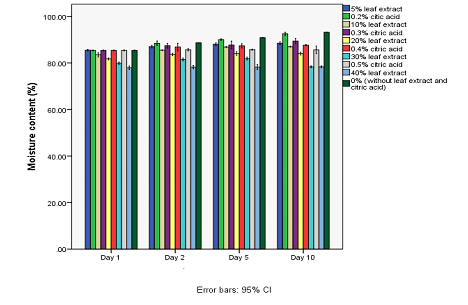
Figure 1: Effect of different concentrations of Ocimum gratissimum leaf extract and citric acid on the moisture content of pineapple juice stored at 30 ± 2°C for 10 days.
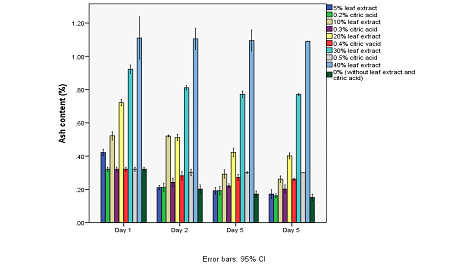
Figure 2: Effect of different concentrations of Ocimum gratissimum leaf extract and citric acid on the ash content of pineapple juice stored at 30 ± 2°C for 10 days.
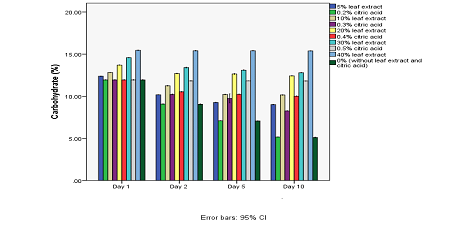
Figure 3: Effect of different concentrations of Ocimum gratissimum leaf extract and citric acid on the carbohydrate content of pineapple juice stored at 30 ± 2°C for 10 days.
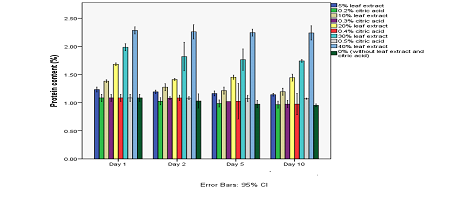
Figure 4: Effect of different concentrations of Ocimum gratissimum leaf extract and citric acid on the protein content of pineapple juice stored at 30 ± 2°C for 10 days.
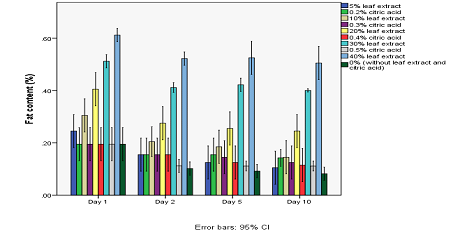
Figure 5: Effect of different concentrations of Ocimum gratissimum leaf extract and citric acid on the fat content of pineapple juice stored at 30 ± 2°C for 10 days.
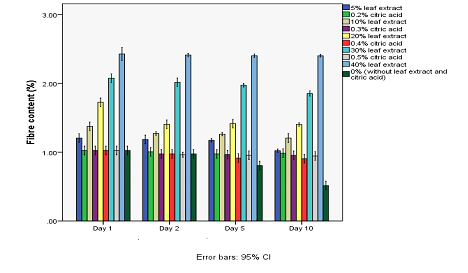
Figure 6: Effect of different concentrations of Ocimum gratissimum leaf extract and citric acid on the fibre content of pineapple juice stored at 30 ± 2°C for 10 days.
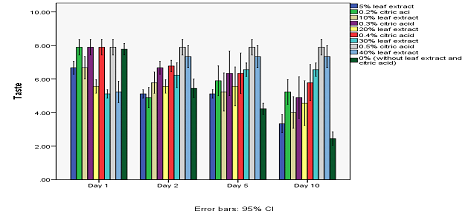
Figure 7: Effect of different concentrations of Ocimum gratissimum leaf extract and citric acid on the taste content of pineapple juice stored at 30 ± 2°C for 10 days.
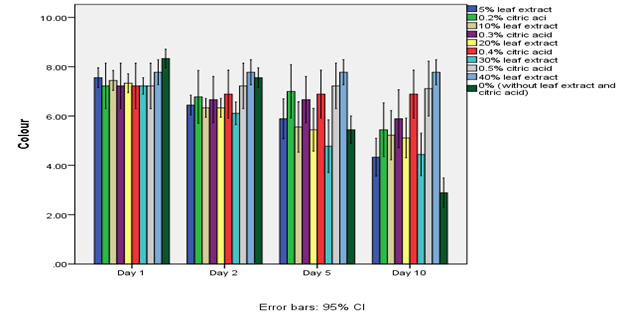
Figure 8: Effect of different concentrations of Ocimum gratissimum leaf extract and citric acid on the colour content of pineapple juice stored at 30 ± 2°C for 10 days.
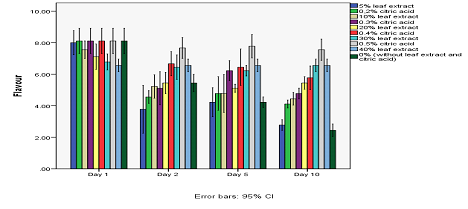
Figure 9: Effect of different concentrations of Ocimum gratissimum leaf extract and citric acid on the flavour content of pineapple juice stored at 30 ± 2°C for 10 days.
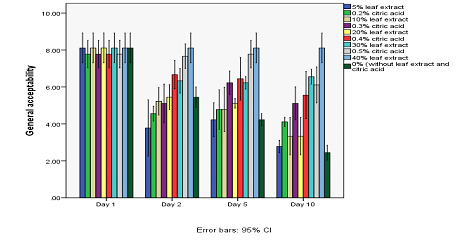
Figure 10: Effect of different concentrations of Ocimum gratissimum leaf extract and citric acid on the general acceptability content of pineapple juice stored at 30 ± 2°C for 10 days.
4. Discussion
The moisture content of pineapple juice treated with different concentrations of O. gratissimum leaf extract was found to be decreasing with increasing concentration of the extract and increasing storage intervals. The moisture content of control was found to be increasing with storage intervals. Both the O. gratissimum leaf extract and citric acid was able to maintain the water content stability of fruit juices compared to the control. Maintenance of stable water content of food items is necessary in order to maintain the nutritive quality of the food items through the shelf life. Increase in water content of food increase the vulnerability of microbial attack of food thereby decrease the shelf life as shown in Figure 1.
However, it was observed that the addition of O. gratissimum plant leaf extract as a preservative to pineapple juice progressively increase the ash content (inorganic mineral elements). It could be therefore be inferred while the addition of O. gratissimum leaf extract increase the mineral contents of fruit juice. It may, therefore, be said that O. gratissimum leaf extract acts a positive effect on the inorganic mineral composition of pineapple juice [15-16]. Ocimum. gratissimum plant leaf extract at different concentrations was found to stabilize the carbohydrate of pineapple juice and the effects increase with increasing concentrations of leaf extract. The carbohydrate in the treated pineapple juice was found to progressively decrease with increasing storage intervals. This may be due to inactivation of microorganisms in the pineapple by the added O. gratissimum extracts which prevented the utilization of the treated pineapple juice sample [17-18].
Different concentrations of O. gratissimum leaf extract were found to be effective in preserving the amount of protein in the pineapple juice compared to the untreated. However, a slight decrease in the protein content of treated pineapple juice was observed with increasing storage intervals. The protein content of the treated pineapple juice with O. gratissimum leaf was observed to be higher than the control (untreated pineapple juice). The increase noted in the treated sample might be the additional effect from the slight protein content present in the extract [16].
Ocimum gratissimum leaf is effective as a preservative in stabilizing the fat content of the pineapple juice sample at different concentrations. However, the fat content of the untreated sample was found to be progressively increased with storage intervals. The increase in the fat content of the control sample was observed with the storage intervals may be attributed to the formation of fatty degradation by-products formed from the biochemical reaction of the microorganisms in the pineapple juice while that of citric acid treated apple juice was found to remain constant with the control throughout the storage intervals. The O. gratissimum extract pineapple juice was observed to have higher fibre content than the untreated samples (control). This is because of the fibre content from the plant extract used for preservation. Therefore it could be inferred that usage of plant extract in pineapple juice preservation increase the fibre content of juice thus, improving the nutrient content [15].
It was noted that the concentration of fatty content in the pineapple fruit juice without preservatives (O. gratissimum leaf extract) ie the control increases as the storage interval progresses. However, the addition of different concentrations of O. extract was able to stabilize the fat content over the period of storage except at low concentration (5%) of the O. extract which was only able to stabilize the fat content of pineapple juice until 2nd day of storage. This percentage of extract fails to acts as a preservative after the 2nd day of storage as shown in Figure 5. The fibre content of preserved pineapple juice with extract (different concentrations) was noted to be higher than that of the control sample (unpreserved). The increase in concentration noted in the preserved pineapple juice samples may be due to the fibre content of O. gratissimum extract used as a preservative. Fibre content adds to the nutritive quality of pineapple juice. Therefore, the increase in fibre content of the preserved juice with leaf extract can be said to be advantageous from the nutritive point of view. It was reported by Adebayo et al. [15] that dietary fibre content is important for lowering blood cholesterol and blood sugar and aids in the emptying of the bowel reduce the risk of diseases such as obesity, diabetes, etc [17]. The fibre content in foods was also been implicated in removing the ingested heavy metals contaminants in [18].
Food spoilage is a metabolic process that causes food to be undesirable or unacceptable for human consumption due to changes in sensory characteristics [19]. The effects of different concentrations of O gratissimum leaf extract and citric acid on the organoleptic properties of fruit juices were considered. O. gratissimum leaf extract was found to have negative on the taste of pineapple juice and this effect increases with increasing concentrations. However, as storage intervals progress, the untreated pineapple juice is progressively regretted by the panelists due to its objectionable taste. The taste of the preserved pineapple juice became acceptable compared to the control from 2nd day through the 10th day of storage. This observation clearly indicated that O. gratissimum leaf extract was able to inhibit some biochemical reaction such as fermentation, enzymatic oxidation [20]. The objectionable taste noted in the untreated pineapple juice could be as a result of the production of alcohol, aldehyde, and ketone ad carboxylic acid through progressive fermentation of fruit juice from fructose.
It was noted that the colour acceptability of pineapple juice decreases with increasing concentration of O. gratissimum plant leaf extract on the day 1 sample compared to control. The colour acceptability of the control decreases progressively with the storage intervals while preserved samples remain mostly acceptable in term of colour throughout the duration of storage [21]. The colour instability of the control could be attributed to biochemical processes in the juice sample which are more pronounced in the control sample. Such reactions include enzymatic browning and enzymatic oxidation amongst others which produces off colours. The acceptability of pineapple juice preserved with different concentrations of O. gratissimum extract decreases with increasing concentrations of the extract. The flavour of the unpreserved juice was noted to become progressively objectionable with increasing storage intervals as shown in Figure 9. The unacceptable of the pineapple flavour with increasing storage intervals could be attributed to the accumulation of biochemical products include alcohol, aldehydes, carboxylic acid, ethers, and ketones. The panelists indicated the alcohol taste in pineapple juice as a deterioration of taste evaluation. The alcohol taste might be appeared because of by-products (organic acids and acetaldehyde) released due to microorganisms such as yeast activity. Yeast spoilage in fruit juices is characterized by formation of CO2 and alcohol. It could be due to non-enzymatic reactions in which sugar is used up, releasing a variety of end products leading to a reduction in the sweetness of the juice and contribute to a fermented flavor [21-23].
5. Conclusions
The results of these studied have shown that Ocimum gratissimum Linn. leaf extract contain some appreciable amount of nutrients which increase the nutritional content of pineapple juice and at same time phytochemicals which stabilize and shielded the nutrient present in juice. A 40% concentration of Ocimum gratissimum was the best to preserve pineapple juice for 10 days. It is therefore recommended as an alternative method of keeping the storage quality of pineapple juice. The panelists rated pineapple juice treated with O. gratissimum leaf extract (40%) the best in terms of colour and general acceptability and slightly affected the taste and flavour while 0.5% citric acid concentration best in flavour and taste evaluated.
Acknowledgments
The authors extend their profound gratitude to the Central Laboratory located at Federal University of Technology Akure Ondo State Nigeria for the availability of equipment and reagents.
Conflicts of Interest
No conflicts of interest.
References
- Baruwa OI. Profitability and constraints of pineapple production in Osun State Nigeria. Journal of Horticultural Research 21 (2013): 59-64.
- Bartholomew DP, Paul RE, Rohrbach KG. The pineapple ‘Botany, Production and Uses’, University of Hawaii Manoa Honolulu, USA (2003).
- Joy PP. Benefits and uses of pineapple. Pineapple Research Station, Kerala Agricultural University, Kerala, India 2010.
- Chaudhary V, Kumar V, Vaishali S, et al. Pineapple (Ananas cosmosus) product processing A review. Journal of Pharmacognosy and Phytochemistry 8 (2019): 4642-4652.
- Dull GG. The pineapple: general. In Ed.: Hulme AC. The biochemistry of fruits and their products, Academic Press, New York 2 (1971): 303-324.
- Debnath P, Dey P, Chanda A, et al. A Survey on Pineapple and its medicinal value. Scholars Academic J. Pharm 1 (2012).
- Martinis JR, Alvarenga AA, Castro EM, et al. Influence of light, temperature, and gibberellic acid on the germination of Ocimum gratissimum L. (Lamiaceae) seeds and evaluation of physiological quality by the X- ray test. Revista Brasileira de Plantas Medicinais 10 (2008): 44-49.
- Effraim ID, Salami HA, Osewa TS. The effect of aqueous leaf extract of Ocimum gratissimum on hematological and biochemical parameters in rabbits. Afr J Biomed Res 3 (2000): 175-179
- Simon J, Peifer M, Bender W, et al. Regulatory elements of the bithorax complex that control expression along the anterior-posterior axis. EMBO J 9 (1990): 3945-3956.
- Nguefact J, Dongmo JBL, Dakole CD, et al. Food preservative potential of essential oils and fractions from Cymbopogan citrates, Ocimum gratissimum, and Thymus vulgar against mycotoxigenic fungi. Int Jour Of food Microbiology 131 (2009): 2-3.
- Christian GD. Preparation of concentration and Expression of Analytical Results in Analytical Chemistry. Published by Hamil- tom Printing company (5th) (1994): 77.
- Abalaka ME, Daniyan SY, Oyeleke SB, et al. The antibacterial evaluation of Moringa oleifera leaf extract on selected bacterial pathogens. J Microbiol Res 2 (2012): 1-4.
- Official Methods of Analysis, 22nd Association of Official Analytical Chemist, Washington D.C (2012): 35-60.
- Iwe MO. Handbook of sensory methods and analysis. PRO JOINT Communications Services Ltd, Enugu (2002): 70-72.
- Adebayo OR, Raimi MM, Oyetade OA, et al. Proximate, Phytochemical and Mineral composition of Ocimum gratissimum seeds condiment. Journal of New Trends in Science and Technology Application 2 (2017): 27-31.
- Talabi JY, Makanjuola SA. Proximate, Phytochemical, and In VitroAntimicrobial Properties of Dried Leaves from Ocimum gratissimum. Prev Nutr Food Sci 22 (2017): 191-194.
- Saldanha LG. Fibre in the diet of U.S. children: Result of national surveys. Pediatrics 96 (1995): 994-996.
- Hajeb P, Sloth JJ, Shakibazadeh SH, et al. Toxic Elements in Food: Occurrence, Binding, and Reduction Approaches. Comprehensive review in Food Science and Food Safety 13 (2014): 457-472.
- Seema Rawat. Food spoilage: Microorganisms and their prevention. Asian journal of plant sciences and research 5 (2015): 47-56.
- Adams MR, Moss MO. The accumulation of biochemical products in fermented milk: In Food microbiology. The Royal Society of Chemistry 3rd (2008): 325-326.
- Mkandawire W, Manani TAN, Kabambe OM, et al. Estimation of Shelf Life of Mango Juice Produced Using Small-Scale Processing Technique. Journal of Food Research 5 (2016): 13-20.
- Lawlor KA, Schuman JD, Simpson PG, et al. Microbiologicalspoilage of beverages, in Compendium of the Microbiological Spoilage of Foods and Beverages. W. H. Food Microbiology and Food Safety, Sperber and M. P. Doyle, Eds., Springer, New York, USA (2009).
- Wardhani AP. Shelf Life Determination of Pineapple Juice Using Extended Storage Studies (ESS) Method. Food Sci Tech Journal 2 (2019): 7-13.


 Impact Factor: * 3.8
Impact Factor: * 3.8 Acceptance Rate: 77.96%
Acceptance Rate: 77.96%  Time to first decision: 10.4 days
Time to first decision: 10.4 days  Time from article received to acceptance: 2-3 weeks
Time from article received to acceptance: 2-3 weeks 